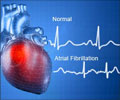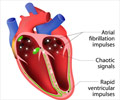How does cancer treatment affect atrial fibrillation and what are the implications for cancer treatment? Can the incidence of atrial fibrillation and stroke risk be lowered?

Under normal circumstances, the heart beats with each contraction and expansion of its muscular walls, which works to pump blood through the body. The heart fills with blood on relaxation and pumps it out on contraction. In atrial fibrillation, there is randomness in the contraction of the upper chambers of the heart as a consequence of which the heart muscles are unable to relax effectively between the contractions. This greatly impairs heart function, as there is a reduction in the efficiency and performance of the heart.
The Cancer Connection
Health care specialists have long contended that there is clear relationship between cancer, cancer treatment and the incidence of atrial fibrillation. Researchers have been studying these links and found that disturbances in cardiac rhythm are rather common among patients who suffer from neoplastic diseases, which could include any condition that involves the growth of abnormal tissue from abnormal and excessive cell division.In many cases the irregularities in heart rhythm are directly associated with the tumor growth itself or with the treatment being provided. Dysrhythmias in cancer patients are often secondary to metabolic abnormalities and are representative of cardiac tissue reactions to changes in the internal environment. The most common cause of such dysrhythmias however is electrolyte shifts. Unfortunately, controlling dysrhythmias is extremely challenging when the heart has been structurally altered because of abnormal tissue growth. Even aggressive treatments often fail to cure or restrict the problem.
Atrial fibrillation becomes problematic most frequently when dealing with lung cancer. If the cancer invades the heart it is classified as a stage IV disease. For this reason, researchers recommend testing for lung cancer in any patient afflicted with atrial fibrillation especially if the patient is exposed to high risks for lung cancer.
A study conducted to assess the impact of atrial fibrillation on patient outcomes and survival within 5 years of a pulmonary lobectomy for lung cancer found that atrial fibrillation is in fact the most common health complication that develops after thoracic surgery. The incidence varied with procedures, with an incidence range of 10 to 20% following pulmonary lobectomies and going as high as 40% with pneumonectomy. Postoperative atrial fibrillation was found to present with even grimmer outcomes as higher hospital morbidity and mortality rates were recorded in such cases and there was also a marked increase in hospitalization and health care costs.
The connection between cancer, cancer treatment and the possibility of complications from atrial fibrillation however may not just be in relation to lung cancer. Toxicities that set in as a result of cancer therapy sometimes only become noticeable years later and the effects on cardiac function can profoundly impact the lives of cancer survivors. In addition to atrial fibrillation, there is also an increased risk of other heart conditions like atherosclerosis, thrombosis, high blood pressure and valvular degeneration. Many of these cardiac dysfunctions can be prevented or detected early in cancer treatment so as to improve the outcome of patients.
Why is this Connection Worrying?
Atrial fibrillation is a worrying condition in itself because of the high risk of stroke that is associated with the condition. In addition to strokes, atrial fibrillation can also ultimately lead to heart failure.Heart Failure – Atrial fibrillation subjects your heart to a great deal of stress because of the consistently high heart rate and the reduced efficiency of blood flow. This eventually weakens the heart muscles and it can result in heart failure, a fatal condition in which the heart is no longer able to pump blood through the body as required.















